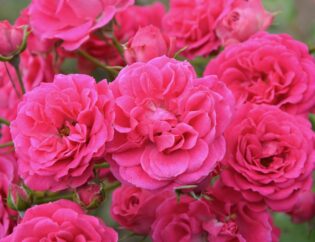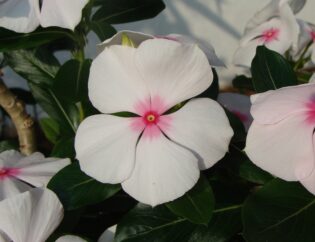
Georgia has the perfect climate for growing a variety of fruits, vegetables, and ornamentals. But plants aren’t the only ones enjoying the weather. Pests like thrips happily settle in and make their living by ruining your garden! Fortunately, thrips control is a straightforward, if tedious, process.
Read on to learn what Atlanta homeowners need to know about thrips control.
What Are Thrips?
There are more than 6,000 species of these plant-killing pests. This article lists the most common ones. They are super small and slender, like a grain of rice, with a taper at the midsection. Adult thrips are about 1/25 of an inch long and are usually yellow-brown or black with red, black, or white markings.
Thrip females lay up to 80 eggs at a time in tiny slits they cut into live plant stems. In warm weather, the eggs can hatch into larvae and pass through two more nymphal stages (wingless larvae).
Once this is complete, most thrips drop to the soil to pupate. Soon after, the new adults emerge (with or without wings, depending on the species) and head back to the plant to start all over again.
The entire process requires less than 16 days during warm weather (longer when it’s cold). This translates to a potential 12-15 generations in a year! That’s a lot of bugs ruining your yard if no measures are taken.
What Damage and Problems Do They Cause?
Thrips feed off the juices of many different types of plants. They are tiny so many people might think it isn’t too big of a deal. Unfortunately, thrips like to party and they invite all their friends to come and hang out.
Their voracious appetites will make quick work of most plants, leaving them pale, splotchy, silvery, and eventually dead. Thrips can also spread bacteria and diseases such as the tomato spotted wilt virus and impatiens necrotic spot virus from one plant to another. Blossoms and fruit? Yep, they destroy those, too.
How Can I Get Rid of Them?
Following a few best practices for thrips management helps cut down on the likelihood of a thrips infestation. When thrips are already present there are a number of options such as insecticidal soaps, pesticides, introducing predatory insects, and organic solutions for getting rid of them.
Organic Options
Those who prefer organic options for controlling thrips will be happy to hear there are various effective methods to naturally kill thrips. Keep in mind that not every treatment kills every life cycle stage. The takeaway? Most treatments need to be applied 2-3 times on a schedule. Here are some of the best ones.
Neem Oil
This natural horticultural oil derived from the neem tree is an effective insecticide for many pests. Mix 1 tablespoon of neem oil and 1-2 teaspoons of liquid castile soap with 1 gallon of water. Spray liberally on infested areas to disrupt the thrips feeding and reproduction cycles. Be sure to get the top and bottom of each leaf.
Organic Insecticidal Soap
Another similar option is to use insecticidal soaps derived from natural plant oils. These are effective against even heavy thrip infestations. The spray works on contact and is ineffective once dry, so it’s safe for bees as long as the spray does not contact them. For that reason, most treatments should be applied at dusk and dawn when they aren’t active.
Natural Pyrethrins
Pyrethrin pesticides are derived from some types of chrysanthemum flowers. These are an organic alternative to chemical thrips control solutions.
Biological Control Methods
Biological thrips management involves introducing species that love to chow down on thrips. Once they get settled in, the massacre begins (hey, they started it). A big benefit of this method is that there is little risk of damage to your plants or beneficial insects, which can happen with general pesticides.
A few good options include:
- Predatory Thrips
- Green Lacewings
- Predatory Mites
- Minute Pirate Bugs
- Some Parasitic Wasps
Be sure to check with the local extension office for suggested species. Greenhouses are especially good places to use predatory insects.
Commercial Pesticides
Sometimes, an infestation requires a commercial solution. There are a variety of options available to Georgia homeowners.
Spinosad
Spinosad tends to be the most effective chemical pesticide against thrips. Its effect lasts for about a week and the spray can drip into nooks and crannies to reach the thrips nestled inside tight spaces.
Systemic Pesticide Granules
Systemic insecticide granules can provide up to 8 weeks of insect control. Application is easy and doesn’t require messy sprays. The plant absorbs the pesticide from the soil, and insects are killed when they try to eat the plant.
Imidacloprid
This pesticide is present in various commonly used pesticides. However, it doesn’t provide adequate thrips control and thus is generally not recommended for this application.
Does Soapy Water Kill Thrips?
Soft-bodied insects like aphids, spider mites, and thrips basically breathe through their skin. Instead of noses or mouths, they breathe through holes in their bodies.
When you spray these types of insects with soapy water, the film suffocates them to death.
However, it only works if there is direct contact. Eating the dried soap afterwards is unlikely to kill thrips. Thus, the soapy water must be applied thoroughly to every surface of the plant.
Are Thrips Hard to Get Rid Of?
The damage caused by thrips doesn’t appear like insect damage at first. Not to mention that the cuts they make and the insects themselves are tiny and very difficult to see.
Because of this, thrips are often discovered once they have already built up a significant population and caused significant damage.
At that point, it becomes difficult, though not impossible, to get rid of thrips.
How Do You Spray Thrips?
Thrips are tiny and can hide easily in the foliage or flower petals of plants. Thus, homeowners must do a thorough job when spraying for thrips.
Begin by cleaning the plants thoroughly with a hose. This will remove some of the insects, dirt, and debris. After the plant has dried, spray the chosen treatment on both the upper and undersides of leaves.
Don’t forget to apply to the trunk and stems as well. The plant must be thoroughly coated to remove every invading thrip. Avoid allowing the product to dry in direct sunlight, some plants can be scorched. The same method can be used for houseplants.
Be mindful of pollinating insects like bees and butterflies. Consider treating the plants in the early evening when these insects are not as active.
7 General Tips for Preventing Pests and Disease
The best methods for thrips control are those that keep the invasion from beginning in the first place. Here are some best practices every homeowner should follow to keep these critters out of their yards.
- Always prune away dead or dying plant material.
- Remove weeds and keep grass mowed around the yard.
- Allow space around plants and trees to allow for good air circulation and sun exposure.
- Keep the garden tidy and do not leave decaying plant material (like last season’s vegetable plants) laying around the yard.
- Do not overwater or leave standing puddles.
- Remove heavily infested or damaged plants and do not compost them.
- Inspect new plants to identify pests before bringing them home.
Take Back Your Yard!
We get it. After the time, money, and hard work is done, it is frustrating to see pests (or other problems) ruin the landscaping! If you’ve got a project in mind, we’re all ears. Contact our landscaping services experts to discuss your landscaping needs and take back your yard!









